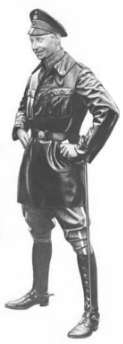Verdun
*
Dates: 21 Feb - 11 July 1916
*
Background: The Verdun offensive, codenamed Operation
Gericht (Judgement) had its beginnings dating to a Christmas
1915 report to
the Kaiser from Chief of General Staff Erich von Falkenhayn
(supposedly, there
is no documentary evidence for this report other than Falkenhayn's
mention of it
in his memoirs). In the report, he confessed
that Germany could not win a drawn out war due to thinning manpower
reserves. He
added that, while England was the great adversary, Germany would be
better off
trying to "bleed the French Army white" thereby forcing a
capitulation. Since the Eastern Front had become fairly stabilized,
Falkenhayn
had the luxury of being able to reconcentrate some of his forces back
west to
break the stalemate. His choice of targets came down to the fortresses
of
Belfort or Verdun, the latter ultimately winning out due to its
proximity to
German railway support. The key to victory, however, was the German
Supreme
Command's conviction that the French would try and protect Verdun at
all costs
(which was in fact what General Petain ordered).
*
The Germans: The massive offensive against the
Verdun salient began on
21 February 1916 under the direction of the Kaiser's eldest son, Crown
Prince
Friedrich Wilhelm, commander of the Fifth Army. The Crown Prince's able
chief of
staff was Lt. General Konstantin Schmidt von Knobelsdorf.
Fifth Army corps commanders included: Lochow (III),
Strantz (V),
Deimling (XV),
Schenck (XVIII),
Guendell (V. Reserves), Gossler (VI. Reserves),
and Zwehl (VII. Reserves). The
Crown Prince never saw a copy of Falkenhayn's Christmas letter, but
rather
received orders to carry out "an offensive in the Meuse area, in the
direction of Verdun." He and his chief of staff falsely assumed that
Supreme Command wanted the fortress captured as soon as possible.
Falkenhayn's
diabolical plan, however, was to release replacement troops to the
Fifth Army
only to maintain the battle but never enough to end it.
|
|

|
|
Friedrich
Wilhelm
|
|
|
Fifth Army
|
Generalleutnant Crown
Prince Wilhelm |
|
III. Corps |
Gen.d.Inf.
Ewald von Lochow |
|
V. Corps |
Gen.d.Inf.
Hermann von Strantz |
|
XV. Corps |
Gen.d.Inf.
Berthold von Deimling |
|
XVIII. Corps |
Gen.d.Inf.
Heinrich Dedo von Schenck |
|
V. Reserves |
Gen.d.Inf.
Erich von Guendell |
|
VI. Reserves |
Gen.d.Inf.
Konrad von Gossler |
|
VII. Reserves |
GenLt. Hans
von Zwehl |
*
The Battle: German artillery bombarded Verdun for
an entire
week, using up a supply of three million shells. In addition to
artillery units
organic to the Fifth, they also brought in the BIG guns: 130-mm,
210-mm, 305-mm, and
420-mm. The following week the Germans advanced steadily along
the narrow front, surprised to find anyone on the French side alive;
they
actually occupied Forts Douaumont and Haraumont by the end of February,
and
later captured Fort Vaux. After a full-scale assault in mid-April
failed, it was
clear to Falkenhayn that Operation Gericht was
futile. Urged along by
Schmidt von Knobelsdorf, however, Crown Prince Willie used his father's
authority to modify the plan; he was determined to achieve a major
victory to
his credit regardless of the cost. But, the battle effectively ended
anyway in
July when German divisions were transferred north to defend against the
Somme
Offensive. Skirmishing in the Verdun region continued through
the end of
1916 with the French retaking the captured forts Douaumont (24 October)
and Vaux
(2 November). The Fifth Army had advanced approximately four miles
beyond the
front, only to fall back to the starting point over 400,000 casualties
later.

* click to
enlarge
home

